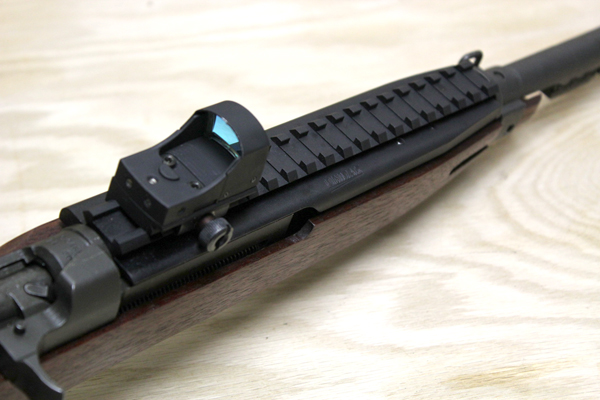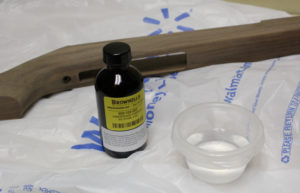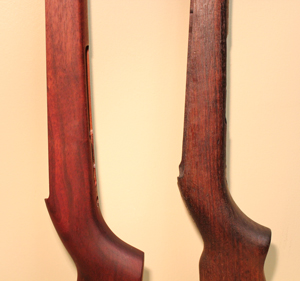

While the M-1 Carbine has been denigrated for lack of stopping power and inaccuracy, it has a lot going for it and, yes, it can even be improved.
Long a favorite of mine, the old M-1 is a favorite of many others, too. Except for gun writers, who seem to hate the thing. This hatred is caused, in my opinion, by a lack of modern ammo development and, I think, a bit of snobbery. Long has the Carbine been denigrated for lack of stopping power, inaccuracy, and an anthropomorphic lack of small round things.
This has always bugged me, because as a short little half-Asian kid in the COLD swamps of Wisconsin, a better deer rifle could not have been found. So, I have traded my uncle’s collectible Winchester for my somewhat beat up CMP Inland. Of course, before long the gunsmith’s curse, the desire to spiff it up became too great.

Did You Ruin a Historic Piece?
So what can be done? I didn’t want the “sporterizing” or butchering like so many of these rifles have been subjected to, but I wanted it to be nicer than it was. This carbine languished in some dank linguini warehouse in Italy for the last 40 or 50 years and the stock looked it, with lots of grease and oil stuck in it. The surface was splintery and otherwise generally rough. The solution to this problem was a new stock, which I ordered from Fulton Armory in Maryland.
This was a brand new walnut stock cut with precision. There was only one thing that did not fit perfectly and it shouldn’t be expected to. The wood surrounding the recoil plate at the back of the receiver stood quite proud, but that was to be expected. In all other areas the stock and handguard fit perfectly and that was in a word, suh-weet. There was also no need to prepare it, as it had already been fully shaped and sanded. I was very pleased with this stock and highly recommend it for replacement or upgrades.
To the accurizing. Referencing The U.S. .30 Caliber Gas Operated Carbines: A Shop Manual by Jerry Kuhnhausen had already proven useful for function and safety checking the rifle. Now the small accurizing section at the back was used to give this humble columnist a clue. Also referenced was the Civilian Marksmanship Program’s website (www.thecmp.org) where a link to accurizing M-1 carbines resides.
There was little disparity of import tween the two, and they said, in a nutshell, the recoil pad needed to be securely bedded, as did a spot under the barrel at the front of the stock. Clint McKee from Fulton Armory was also a wealth of information.
Beginning the Work

Using a vertical mill, I removed wood from under the recoil plate and around it, leaving a very slight shelf around the edge of the screw hole area for locating purposes. To fashion a tube for the recoil plate’s screw (so as no bedding contacted it), I cut and unrolled the rolled aluminum handle of one of the acid brushes in the Brownells bedding kit, then re-rolled it around the recoil plate screw, and then cut to size.
I then inserted this resulting tube into the hole in the stock and the bedding compound was then applied around it. (I bet Brownells didn’t see that one coming). The recoil plate, thoroughly coated with release agent was then smushed into the bedding compound and seated on that little locater shelf left behind. Of course the compound proceeded to ooze about and the stock around the recoil plate then needed some cleanup.
I then inserted the action in the stock in order to insure that the recoil plate was properly aligned straight ahead, and tightened the screw. Once the compound was sufficiently set, the action, and then the recoil plate were removed to allow the compound to finish hardening.
I next dug out a small channel just behind where the inner fingers of the barrel band wrap around the barrel at the front of the stock. The Kuhnhausen manual indicated placing the front bedding pad under these fingers but I didn’t want to mess with that so I placed this bedding pad just behind them. I figured since the pad was just about in the same place, its function being to provide a secure base for the barrel, that it should work out just as well a half inch displaced.
Next was to modify if necessary the recoil plate, so that it caused the barrel to sit slightly high above the forend pad, thus causing a certain small amount of constant tension to be placed on the barrel when the barrel band was installed. Fortunately, there was about 1/8 of an inch of float there inherently, so I decided to leave it be and not attempt to add more.
The last step was to stain the stock with the Vanderhave formula XIII from Brownells. This stuff is supposed to duplicate the dark, slightly reddish color of the old WWII stocks. I thinned it out a little using alcohol and used an old, yet still white, sock to apply it to the wood.
I rubbed in a rather dilute coat to act as a sealer and a less dilute coat to actually stain the stock and handguard. Following up, two nice coats of tung oil were rubbed in and the stock sat for a few days before I used a 1000-grit piece of sandpaper to lightly take the shine off the top coat of tung oil. Lo and behold, it looked pretty darned good, having a slight reddishness and being just a teensy shade lighter than the oil-saturated stock the carbine came in.

The final piece of the equipment upgrade was to add a scout rail, which replaces the handguard. This rail was made by Ultimak and obtained from Brownells.
This handy rail directly replaces the handguard with an aluminum section topped with a Picatinny rail. All sorts of stuff can be added here, like a scout style extended eye relief scope, but I just put on a cheap, little micro-red dot sight. It should be noted that installing anything onto this rail will remove the iron sights from play, and anything placed there may wind up getting rather warm from heat transfer off the barrel. Then it was off to the range.
Range Report
I test fired for groups prior to the upgrades and with my somewhat poor abilities got roughly 3-inch groups at 50 yards, shooting 10-round groups. Not five. Not three. Anyone pawning off five-shot groups and calling them representative is telling fish stories. Anyone using three-shot groups, or best three of five, is flat out lying to you, pulling fabrications from a certain posterior fissure. The more shots, the better, and 10 or more shots will open up a bit from 5 shots, hence the reason gun writers and manufacturers like to use five-shot groups, but it just isn’t a valid scientific representation.
The 10-shot group is little better, but the difference between a 10-shot and a 20-shot is almost always far smaller than the difference between a five and a 10.
Post upgrade, the best group I had was nine shots out of 10 in a 1-inch ragged hole, with the tenth another inch away, a “flyer” if you will. Still, a 2-inch 10-shot group is a lot better than a 3-inch 10-shot group.
All post-upgrade groups shot at least slightly smaller than pre-upgrade. Reloads from Wisconsin Cartridge Corporation, and factory Remington UMC were used, with the UMC getting the best groups. Incidentally, I also loaded up some Barnes 100-grain X-bullets (no longer available) and they shot pretty crappy. Six inch group. I really hope it was poor reloading technique.
This article appeared in the February 14, 2011 issue of Gun Digest the Magazine.

Next Step: Get your FREE Printable Target Pack
Enhance your shooting precision with our 62 MOA Targets, perfect for rifles and handguns. Crafted in collaboration with Storm Tactical for accuracy and versatility.
Subscribe to the Gun Digest email newsletter and get your downloadable target pack sent straight to your inbox. Stay updated with the latest firearms info in the industry.









well, its all fun and games until kevin doesnt post picks of that which he speaks.. cant you mayhaps email some..?
I was reading this article on my email “google reader” and knew who the author was even before I checked the name on the top. Great to see you following your passions man. Nice article.
Greeting from Wisconsin!
Derek